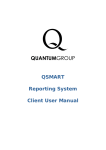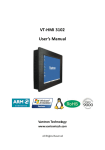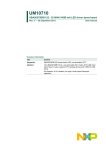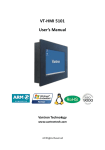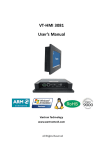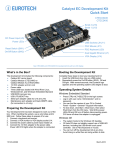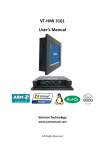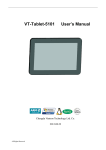Download Eurotech Helios Specifications
Transcript
HARDWARE REFERENCE MANUAL Helios™ Platform Programmable Edge Controller Rev. 2 - October 2009 DIGITAL TECHNOLOGIES FOR A BETTER WORLD www.eurotech.com Disclaimer The information in this document is subject to change without notice and should not be construed as a commitment by any Eurotech company. While reasonable precautions have been taken, Eurotech assumes no responsibility for any error that may appear in this document. Trademarks Helios™ and Everyware™ are trademarks of Eurotech Inc. All other product or service names are the property of their respective owners. Revision History Issue no. 1 2 PWB Date Comments Jul-09 Initial release, preliminary Oct-09 Second release, preliminary © 2009 Eurotech Inc. For contact details, see page 27. Contents Contents Introduction ............................................................................................................................ 5 Block Diagram ........................................................................................................... 5 Features .................................................................................................................... 6 Further Reading ......................................................................................................... 7 Handling Your System Safely ..................................................................................... 7 Conventions ............................................................................................................... 7 Software Support ................................................................................................................... 9 Operating System ...................................................................................................... 9 BIOS .......................................................................................................................... 9 Boot Options .............................................................................................................. 9 Everyware™ Software Framework ............................................................................. 9 Getting Started ..................................................................................................................... 10 Components ............................................................................................................ 10 Connectivity ............................................................................................................. 10 Hardware Reference............................................................................................................ 12 Rear Panel ............................................................................................................... 12 Connectors................................................................................................... 13 Boot Mode Switch ........................................................................................ 14 USB Bay .................................................................................................................. 14 Indicators ................................................................................................................. 15 Enclosure ................................................................................................................. 16 Configurations ..................................................................................................................... 17 Processor ................................................................................................................ 17 Memory .................................................................................................................... 17 CompactFlash® Card or SD Card ................................................................ 17 On-Board Flash ............................................................................................ 17 SATA Drive ................................................................................................... 17 USB Disk Drive ............................................................................................ 17 Communications ...................................................................................................... 18 Universal Serial Bus ..................................................................................... 18 Serial Port .................................................................................................... 18 Ethernet ....................................................................................................... 18 GPS ............................................................................................................. 18 Multimedia Cards ..................................................................................................... 18 Power Supply........................................................................................................... 19 Peripherals .......................................................................................................................... 20 USB Device Support ................................................................................................ 20 System Specification............................................................................................................ 21 Processor ................................................................................................................ 21 Power ...................................................................................................................... 21 Power Supply ............................................................................................... 21 Power Consumption ..................................................................................... 22 110124-30002, preliminary 3 Helios Platform Hardware Reference Manual Electrical .................................................................................................................. 22 Real-Time Clock ........................................................................................... 22 Audio Interface ............................................................................................. 23 SATA Drive ................................................................................................... 23 EMI/EMC ................................................................................................................. 23 Environmental .......................................................................................................... 24 Appendix A – Reference Information .................................................................................... 25 Appendix B – System Revision ............................................................................................ 26 4 110124-30002, preliminary Introduction Introduction Helios™ is a programmable edge controller that provides a flexible application-ready hardware platform with enhanced wireless capabilities. It is based on the Catalyst Module which integrates with a base board and supporting peripheral devices. All electronics are housed in an enclosure. Three USB host ports for wireless devices and additional storage are accessible in the USB Bay located under the removable cover. With the Helios platform, you can quickly and easily create an edge controller device, loaded with your application software that precisely meets your requirements. Several options are available allowing you to choose the hardware based on your specifications. Using pre-certified wireless modules in the USB Bay, the Helios platform can be easily customized for any network. Software support includes Eurotech’s Everyware™ Software Framework (ESF) offering simple to use APIs. Block Diagram The following diagram illustrates the system organization of the Helios platform. Notice that the data connector on the Catalyst Module has been divided into two sections for this illustration. Dotted lines indicate configuration options. For information about these options, see Configurations, page 17. Helios™ Platform Catalyst Module XL Intel® Atom™ Processor SATA Drive SATA Controller DDR-2 DRAM FSB 1 x PCIe Gigabit Ethernet GigE Controller 3 x USB2.0 Host (USB Bay) 3 x USB2.0 8 x LED USB to Serial GPS Rcvr Momentary Switch I2C GPIO Regulated Power (optional Vehicle Pwr) Pwr Supply SD/MMC Intel® SCH US15W HD Audio Audio Codec Stereo Line In Stereo Line Out Microphone In SDVO to VGA VGA Display Out LVDS Video 1 x USB2.0 1 x USB2.0 SMBus SMBus GPIO LM75 Temp Monitor CompactFlash 1 x SD/MMC SDVO 4 Port Hub GPS IDE/PATA 2 x USB2.0 2 x USB2.0 Host EIA 232/485 1 x PCIe On-board PATA flash Multimedia Card Support (VGA option board shown) LPC Bus GPIOs I2C Sys Mgmt I/O V Reg Embedded Ctrl TPM BIOS VBAT (RTC) BAT 110124-30002, preliminary 5 Helios Platform Hardware Reference Manual Features Processor • Catalyst Module - Intel® Atom™ processor at 1.1 GHz (up to 1.6 GHz options) Intel® System Controller Hub US15W 512 MB DDR-2 DRAM (up to 2 GB options) Battery-backed real-time clock Memory • CompactFlash® card or SD card (option) • On-board PATA flash (option) • Internal SATA drive (option) • External USB disk drive support Communications • Five USB 2.0 host ports operating low, full, and high speeds - Two general-purpose ports Three USB Bay ports for wireless devices and storage (option for up to three external antenna connections) • EIA-232 or EIA-485 serial port (software-selectable) • Gigabit Ethernet port • GPS with external antenna connection (option) User Interface and Display • Multimedia card support for display and audio options - - VGA options board (currently available) VGA display out Stereo line output and stereo line input Mono microphone input (For additional options boards, see Multimedia Cards, page 18.) • Eight software-controlled LED status indicators • Software-readable push-button Power Supply • 12 V DC power input (up to 36 V vehicle power input option) • Power management support capable of operation at < 3W Mechanical • 6 ABS plastic and aluminum enclosure 110124-30002, preliminary Introduction Further Reading This document describes the Helios platform and is intended for system integrators. A system-level overview is provided in the following sections. The following documents are also important resources for developing applications for the Helios platform. Document Helios Platform Dev Kit Quick Start 110124-3003 Helios Platform Dev Kit with VGA option Quick Start 110124-3004 Check the Eurotech support site (http://support.eurotech-inc.com/) for errata reports and for the latest releases of these documents. Handling Your System Safely Anti-Static Handling The Helios platform is designed to meet the Electrostatic Discharge (ESD) criteria contained in IEC 61000-4-2 (EMC – Part 4-2: Testing and Measurement Techniques – Electrostatic Discharge Immunity Test). The electronics included in the enclosure contain CMOS devices that could be damaged by electrostatic discharge (ESD). Observe industry-standard electronic handling procedures when handling these electronics. Where possible, work on a grounded anti-static mat. At a minimum, touch an electrically grounded object before handling any electronics. Packaging Please ensure that, should a system need to be returned to Eurotech, it is adequately packed, preferably in the original packing material. Electromagnetic Compatibility The Helios platform is defined as an unintentional radiator of electromagnetic energy. For additional information about the EMI/EMC specification, see EMI/EMC, page 23. Conventions The following table lists the symbols used in this document. Symbol Explanation Note – information that requires your attention Warning – proceeding with a course of action may damage your equipment or result in loss of data 110124-30002, preliminary 7 Helios Platform Hardware Reference Manual The following table describes the conventions for signal names used in this document. Convention Explanation GND digital ground plane + positive signal in differential pair - negative signal in differential pair The following table describes the abbreviations for direction and electrical characteristics of a signal used in this document. 8 Type Explanation I signal is an input to the system O signal is an output from the system IO signal may be input or output P power and ground nc no connection reserved use is reserved to Eurotech 110124-30002, preliminary Software Support Software Support Eurotech provides an application-ready platform including BIOS, operating system, and development environment. This section gives a brief description of the software support available for the Helios platform. For additional details, contact your local Eurotech technical support. Operating System The Helios platform is available with the following operating systems: • Wind River Linux 3.0 • Windows® Embedded Standard • Windows CE 6.0 BIOS The Helios platform incorporates a custom system BIOS developed by Eurotech. Boot Options The Helios platform has the capability to boot and install the operating system from five sources. The following are the boot options: • CompactFlash card • USB disk drive • SD card • SATA drive • On-board PATA flash Everyware™ Software Framework Everyware Software Framework (ESF) is an inclusive software framework that puts a middleware layer between the operating system and the OEM application. It provides industry-standard interfaces that shorten development time, simplify coding, and allow software to be ported from one Eurotech hardware platform to another. ESF is available on the Helios platform. For information about ESF, refer to the Eurotech website (http://www.eurotech.com). 110124-30002, preliminary 9 Helios Platform Hardware Reference Manual Getting Started The Helios platform is configured to acquire its network address automatically using Dynamic Host Configuration Protocol (DHCP). This section describes how to determine this address before you begin development. Components To get started, you will need the following components: • Helios platform • Power supply (12 VDC adapter and regional AC power cord) • Null modem cable (DB9FF) • Ethernet cable • Computer with EIA-232 serial port, terminal emulation program, network connection, and SSH client program • DHCP server Connectivity To determine the network address, complete the following steps: 1. Connect any available serial port of the computer to the EIA-232 serial port using the null modem cable. 2. Open a terminal emulation program on the computer with the following port settings: Baud rate: 9600 Data bits: 8 Parity: none Stop bits: 1 10 110124-30002, preliminary Getting Started 3. Connect your network cable to the Ethernet socket. 4. Connect the 12 VDC adapter to the DC power input. 5. Connect the 12 VDC adapter to AC power. The power LED illuminates green when the adapter is connected. After several seconds, the operating system boots and the system sends console output to the terminal. 6. Retrieve the IP address displayed on the terminal. After the message “Bringing up interface eth0” is displayed, the IP address is given as “inet addr:”. 7. Use a SSH client program and the IP address to log in remotely. 110124-30002, preliminary 11 Helios Platform Hardware Reference Manual Hardware Reference This section gives an overview of the hardware features of the Helios platform. The overview includes location and function of connectors, indicators, and switches and details about the enclosure. Rear Panel The following diagram illustrates the location of connectors and switches on the rear panel. Notice that the system shown uses the VGA options board and includes additional connectors not found on the standard system. For other multimedia card options, see Multimedia Cards, page 18. Microphone Antenna Connections Line Out Video Line In Power Serial USB Switch Ethernet GPS Standard system The following table describes the connectors on the rear panel of a standard system. 12 Connector Enclosure Connector Description Antenna 1-3 Device dependent USB device external antenna connections Power 1 x 2 header, 3.5 mm Main power input USB 1-2 USB Type A receptacle USB 2.0 host ports Serial DB-9 plug EIA-232 (default) or EIA-485 Ethernet RJ-45 socket Gigabit Ethernet network GPS SMA socket GPS external antenna connection 110124-30002, preliminary Hardware Reference VGA Option The following table describes the additional connectors on the rear panel of a system that includes the VGA options board. Connector Enclosure Connector Description Microphone RCA jack Mono microphone input Line In RCA jack Stereo line in Line out RCA jack Stereo line out Video DE-15 socket VGA video output Connectors The following tables describe connectors that do not follow an industry-standard pinout. Power Input Connector: Mating connector: 2-pin header, 3.5 mm, Phoenix Contact 1937318 2-pin plug, Phoenix Contact 1847055 The Helios platform accepts input power from a regulated external supply. For details about input power options, see Power Supply, page 19. Pin Name Type Description 1 GND P ground 2 VIN PI 12 V (nominal) power input Serial Port Connector: Mating connector: DB9 plug DB9 socket By default the Helios platform provides an EIA-232 serial port. As a software-controlled option, this port can be configured for EIA-485 operation. EIA-232 (default) Name Type Description EIA-485 Name Type Description 1 DCD I Data Carrier Detect RX+ I Receive Data + 2 RXD I Receive Data RX- I Receive Data - 3 TXD O Transmit Data TX- O Transmit Data - 4 nc TX+ O Transmit Data + 5 GND GND P ground 6 nc 7 RTS O Request To Send nc 8 CTS I Clear To Send nc 9 nc Pin 110124-30002, preliminary P ground nc nc 13 Helios Platform Hardware Reference Manual Boot Mode Switch The Helios platform includes a momentary push-button switch accessible through a small hole on the rear panel near the GPS connector. This switch generates an interrupt to the processor and is software-definable. USB Bay The following diagram illustrates the location of connectors inside the USB Bay. USB Sockets with Locking Latches Antenna Connections The three USB 2.0 host ports located in the USB Bay permit use of wireless USB devices inside the enclosure. These ports use USB sockets with locking latches preventing accidental disconnects or lost connections due to vibration. Each USB port includes a corresponding connection for an external antenna. The type of connection is dependent on the USB device used. Some USB devices will not fit in the USB Bay or require cabling external to the enclosure. For these types of devices, cables for the USB interface can plug into the locking sockets in the USB Bay and then pass through the larger external cooling vents in the bottom of the USB Bay cover. A CAN interface is one example of such a device. For additional information about the enclosure, see Enclosure, page 16. Warning: Do not forcibly pull on the USB device to disconnect. Raise the latch on the socket to remove the device. 14 110124-30002, preliminary Hardware Reference Indicators The Helios platform has eight red/green/yellow light-emitting diodes (LEDs) that are software-controlled. The following diagram illustrates the location of the LEDs. The LEDs are visible to the operator on two sides of the enclosure. LEDs 8 1 The following table describes the LEDs on the enclosure. LED CR (note 1) Description Device Controller Red Signal Green Signal 1 8 Serial activity USB UART IC CBUS4 CBUS3 2 1 Power SMBus GPIO P1 P0 3 2 Software-definable SMBus GPIO P3 P2 4 3 Software-definable SMBus GPIO P5 P4 5 4 Software-definable SMBus GPIO P7 P6 6 5 SATA activity SATA Controller LED0 SATA Controller LED1 7 6 Software-definable I2C GPIO P1 8 7 SD card activity SMBus GPIO P2 SCH US15W P0 SLOT0_LED Note: 1. CR refers to the reference designator located on the base board. LED2 indicates system power. By default, LED2 is illuminated green when power is applied. 110124-30002, preliminary 15 Helios Platform Hardware Reference Manual Enclosure The Helios platform is housed in an enclosure 25.9 x 12.1 x 4.5 cm (10.2 x 4.75 x 1.75 inches) in size, as shown in the following diagram. Removable USB Bay Cover Screws External Cooling Vents This enclosure includes the following features: • ABS plastic • Adaptable I/O side plates • Removable USB Bay cover - • Aluminum base plate - • Accommodates USB devices with length up to 3.5 inches Includes security screws to secure the cover to the enclosure Uses 7/64-inch hex key to open the cover Provides various mounting options Supports thermal management External cooling vents - Allows cooling by an external fan Provides openings for routing cables external to the enclosure Note: To open the USB Bay, use the 7/64-inch hex key supplied with the development kit. 16 110124-30002, preliminary Configurations Configurations The Helios platform’s flexible design enables several options supporting many possible combinations to meet your system requirements. These options are factory-installed, and the system is configured for operation at the factory with the specific combination of options. This section describes the options available for the Helios platform. Processor The Helios platform bases its architecture on the high-performance, low-power Catalyst Module. This module is available in various versions based on the following features: • Processor speed • On-module DRAM • Operating temperature The standard system includes a 1.1 GHz, 512 MB Catalyst Module XL for the industrial temperature range. For the various performance variants, see Processor, page 21. Memory Five types of memory provide mass storage options for the Helios platform. In addition, the system can boot from any of these memory options. For information about boot options, see Boot Options, page 9. The following sections describe the memory options. CompactFlash® Card or SD Card As an option, the Helios platform can include a CompactFlash® card or Secure Digital/MultiMedia (SD/MMC) card. Both media provide mass storage in a wide variety of capacities. Each type of card is located internal to the enclosure and is not accessible when the system is completely assembled. Note: The CompactFlash card option is mutually exclusive with the SD card option. Only one card can be installed. On-Board Flash On-board PATA flash is available as an option populated in increments of 1 GB. SATA Drive As an option, the Helios platform can include a single, 2.5-inch form factor SATA drive internal to the enclosure. For SATA drive specifications, see SATA Drive, page 23. USB Disk Drive A USB disk drive can connect to any of the five USB host ports on the Helios platform. 110124-30002, preliminary 17 Helios Platform Hardware Reference Manual Communications A key capability of the Helios platform is its network and wireless connectivity. The system offers five USB host ports, an EIA-232/485 serial port, a Gigabit Ethernet port, and GPS. The following sections describe these interfaces. Universal Serial Bus Five Universal Serial Bus (USB) ports included on the Helios platform support connectivity with a wide range of available USB devices. All ports support the USB 2.0 specification operating at low, full, and high speeds. For power requirements, see Power, page 21. Two ports are general-purpose USB host ports accessible on the rear panel, while the remaining three ports are located in the USB Bay. For additional information about these USB ports, see USB Device Support, page 20. Serial Port The Helios platform provides a serial port accessible on the rear panel. By default, this port is an EIA-232, 6-wire interface. Under software-control, the port can be configured as an EIA-485 interface. Ethernet For network connectivity, the Helios platform includes a Gigabit Ethernet port. GPS The standard system includes a “u-blox” GPS module with an external antenna connection on the rear panel. This module is a population option. Multimedia Cards To provide custom display and audio solutions, the Helios platform includes an internal card slot for add-in multimedia cards. This hardware flexibility enables the Helios platform to support a wide variety of display types and audio requirements. Display Output The Helios platform supports the following display output options: • VGA with max resolution of 1366 x 768 (currently available) • CVBS, S-Video, or HDTV • HDMI • DVI-D • LVDS with 24-bit color, touch screen (4, 5, or 8-wire), and backlight Note: The VGA options board is currently available. Other boards will be available as future options. 18 110124-30002, preliminary Configurations Audio Interface The multimedia card slot includes an Intel HD Audio interface to support an audio codec on the add-in card. The Intel HD Audio specification defines an industry-standard interface for implementing high quality audio in an embedded environment. Currently, the VGA options board provides the following audio capabilities: • Stereo line output and stereo line output • Mono microphone input For electrical specifications, see Audio Interface, page 23. Power Supply The standard system requires a regulated DC power input. As an option, the Helios platform can be powered from vehicle rated power. For power specifications, see Power, page 21. 110124-30002, preliminary 19 Helios Platform Hardware Reference Manual Peripherals Support for a wide variety of plug-in USB devices enables the Helios platform to be easily customized for any application. This section describes the types of peripherals available for use with the Helios platform. USB Device Support The three USB ports located in the USB Bay expand the capability and connectivity of the Helios platform, in addition to providing the option to boot from a USB device. These ports enable customization for your specific application with no hardware modifications to the system. The Helios platform supports the following types of USB devices: • Cellular modem • ZigBee • Wi-Fi • Bluetooth • Telematics / CAN • Mass storage • HID (Human Interface Device) For additional information about the USB Bay, see USB Bay, page 14. Eurotech has pretested and approved several USB devices for use with the Helios platform. For the latest list of devices, contact your local Eurotech sales representative. 20 110124-30002, preliminary System Specification System Specification Processor The Helios platform is based on the Catalyst Module and is compatible with all versions of the module allowing several performance variants. The following table specifies the processor performance. Max Units Processor operating frequency (commercial) Parameter (note 2) 1100 Min 1600 MHz Processor operating frequency (industrial) 1100 1330 MHz Front side bus clock 400 533 MHz Front side bus width Typ. 64 On-board DDR-2 DRAM 512 bit 2000 MB Notes: 2. The standard system includes a 1.1 GHz, 512 MB Catalyst Module XL for the industrial temperature range. Power Power Supply The following table specifies the power requirements for the Helios platform. For additional information about the input voltage options, see Power Supply, page 19. Symbol Parameter Min Typ. Max Units 10.8 12 13.2 V 36 V Input Voltage, Standard Application VIN Input voltage VINTRANS Input transient voltage Input Voltage, Vehicle Application VIN Input voltage (note 3) VINTRANS Input transient voltage IUSB USB current (note 4) 9 36 V 100 V 1 A USB Notes: 3. The Helios platform is designed to be unpowered when vehicle ignition is off. 4. The total current drawn from all USB ports must be less than 3 A. 110124-30002, preliminary 21 Helios Platform Hardware Reference Manual Power Consumption The following table lists power consumption for various configurations of the Helios platform. Symbol Parameter Min Typ. Max Units Fully loaded, without USB (note 5) P IINRUSH Power 12 Inrush current W 17 A Fully loaded, with USB devices (note 6) P IINRUSH Power 15 Inrush current W 18 A Notes: 5. Power consumption was measured on a Helios platform with a VGA options board and the following conditions: 12 V input voltage, video and audio clips playing from a SATA drive, Ethernet port pinged, serial port transferring a file in 1K XMODEM at 115200 baud, and GPS unit responding consistently. 6. Power consumption was measured on a Helios platform with a VGA options board and the following conditions: 12 V input voltage, Belkin Wi-Fi device enabled and playing a video, Verizon cellular modem enabled, video and audio clips playing from a SATA drive, Ethernet port pinged, serial port transferring a file in 1K XMODEM at 115200 baud, and GPS unit responding consistently. Electrical This section provides electrical specifications for the Helios platform. Real-Time Clock The Helios platform provides a RTC function that retains the system date and time. To supply backup power when the power input is disconnected, the system includes a longlife, lithium coin battery. The following table specifies the RTC function. Parameter Accuracy per month @ 25°C Battery Operating temperature Typ. Units +/-55 sec 3 V -30 to +80 °C Warning: The RTC battery is located under the Catalyst Module and is not user serviceable. Incorrect removable of the module or battery could damage the Catalyst Module. 22 110124-30002, preliminary System Specification Audio Interface The VGA options board includes an IDT 92HD71B8 4-channel HD audio codec providing an audio option for the Helios platform. For additional information, see Multimedia Cards, page 18. Symbol Parameter Min Typ. Max Units DVDD Codec digital supply voltage 3.3 V AVDD Codec analog supply voltage 3.3 V fS Sample rate 192 kHz --- A/D sample resolution 24 bit Line In, Microphone VIN Full scale input voltage 1.00 1.03 0 Vrms GainIN Microphone boost 30 dB RIN Input impedance 50 kΩ CIN Input capacitance 15 pF Line Out VOUT PUT Full scale output voltage 0.707 Headphone output, 32Ω load 31 0.758 Vrms 42 mW (peak) SATA Drive The following table lists the specification for the optional SATA drive. For additional information, see SATA Drive, page 17. Parameter Min Typ. Transfer rate (SATA2) Power consumption (seek) Power consumption 1 Max Units 300 MBps 3 W W EMI/EMC The Helios platform is designed to meet the EMI/EMC requirements listed in the following table. The external USB wireless devices are covered by separate qualifications. Requirement Characteristic Condition/Comments EN 55022/CISPR22 Emissions Sub-clause 8.2 - EN 55022/CISPR 22 for class B device - Radiated emissions for 30 MHz – 1 GHz EN 55022/CISPR22 Immunity Sub-clause 9.3 - EN61000-4-2 - Electrostatic discharge. Sub-clause 9.2 - EN 61000-4-3 - Radiated immunity FCC CFR47 Part 15/B Emissions Rules 15.101-109 110124-30002, preliminary 23 Helios Platform Hardware Reference Manual Environmental The Helios platform is designed to meet the environmental specifications listed in the following table. Parameter Specification Operating temperature (note 7) -40°C to +85°C Vibration profile SAE J1455-2006, vehicle Shock Mil-Std-810F, 20 g/s, 11 ms Drop 1 m, hard surface, cosmetic damage only Humidity 95% non-condensing Ingress protection (IEC 60529) IP-50 (note 8) Notes: 24 7. Operating temperature is 0°C to 70°C for the 1.6 GHz option. 8. Enclosure protects electronics from dust. It does not protect against water ingress. 110124-30002, preliminary Appendix A – Reference Information Appendix A – Reference Information Product Information Product notices, updated drivers, support material: www.eurotech.com Intel Information about the Intel Atom processor, Intel System Controller Hub US15W, Intel High Definition Audio specification: www.intel.com USB Universal Serial Bus specification and product information: www.usb.org SD Card SD Card Association and SDIO specification: www.sdcard.org MMC Card JEDEC MMC 4.0 specification: www.jedec.org CompactFlash CompactFlash Association and specification: www.compactflash.org 110124-30002, preliminary 25 Helios Platform Hardware Reference Manual Appendix B – System Revision This manual applies to the current revision of the Helios platform as given in the following sections. Revision History The following is an overview of the revisions to the system. Revision 1 Prototype 26 110124-30002, preliminary Eurotech Worldwide Presence AMERICAS EUROPE ASIA North America Central & Southern Europe Japan EUROTECH North America Toll free +1 888.941.2224 Tel. +1 301.490.4007 Fax +1 301.490.4582 E-mail: [email protected] E-mail: [email protected] Web: www.eurotech-inc.com EUROTECH Italy Tel. +39 0433.485.411 Fax +39 0433.485.499 E-mail: [email protected] E-mail: [email protected] Web: www.eurotech.com ADVANET Tel. +81 86.245.2861 Fax +81 86.245.2860 E-mail: [email protected] Web: www.advanet.co.jp Western Europe China EUROTECH United Kingdom Tel. +44 (0) 1223.403410 Fax +44 (0) 1223.410457 E-mail: [email protected] E-mail: [email protected] Web: www.eurotech.com VANTRON Tel. +86 28.85.12.39.30 Fax +86 28.85.12.39.35 E-mail: [email protected] E-mail: [email protected] Web: www.vantrontech.com.cn PARVUS Tel. +1 800.483.3152 Fax +1 801.483.1523 E-mail: [email protected] E-mail: [email protected] Web: www.parvus.com EUROTECH France Tel. +33 04.72.89.00.90 Fax +33 04.78.70.08.24 E-mail: [email protected] E-mail: [email protected] Web: www.eurotech.com Northern & Eastern Europe EUROTECH Finland Tel. +358 9.477.888.0 Fax +358 9.477.888.99 E-mail: [email protected] E-mail: [email protected] Web: www.eurotech.com www.eurotech.com




























